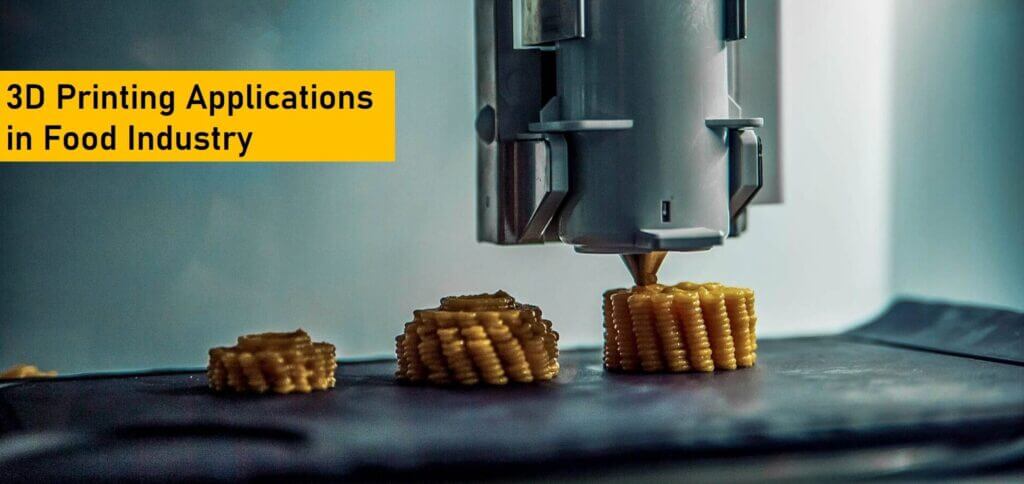While discussing the transformative impact of additive manufacturing or 3D printing technologies, bloggers often focus on technology-driven industries like aerospace, automotive, and medical. But 3D printing technologies have already transformed the production, storage, transportation, and distribution of various food products and services.
The companies and startups engaged in the food industry have been leveraging 3D food printing technologies to reduce operational costs and improve operational efficiency and customer experiences. Several market research studies suggest a steady growth in the worldwide 3D food printing market.
According to a research report published by MarketsandMarkets,
“The 3D food printing market is estimated to account for nearly USD 201 million in 2022 and is projected to reach a value of nearly USD 1,941 million by 2027, growing at a CAGR of 57.3% from 2022.”
The projected growth depicts the varying 3D printing applications in food industry. Companies and startups have been creating new use cases of 3D food printing regularly. We can understand the important applications of 3D food printing based on some of these common and emerging use cases.
Understanding Varying 3D Printing Applications in Food Industry
Experimenting with Cuisines
The lockdowns and shutdowns caused by COVID-19 created opportunities for people to experiment with new cuisines. While working from home, many people find time to cook new food items and make changes to existing reports. After the pandemic, people continue to explore ways to experiment with new cuisines.
The affordable food 3D printers create opportunities for such people to experiment with new dishes without putting in extra time and effort. A person can use the food 3D printer to create new food dishes in minutes. Also, she can prepare innovative food dishes simply by altering or finetuning digital files.
Creating Customized Food Designs
The appearance and presentation of a food dish impact the diner’s experiences just like its taste and flavor. Restaurants and eateries focus extensively on improving customer experience by customizing and finetuning various food designs.3D printers enable users to produce detailed and complex items from digital files.
A chef can create innovative food designs using 3D modeling software and convert the digital 3D model into innovative food designs using a food 3D printer. Many restaurants leverage food 3D printing to impress customers by customizing food designs and personalizing food dishes according to their preferences.
Driving Food Production Automation
Businesses from various industries adopt additive manufacturing to save time and resources through process automation. Like other enterprises, the companies and startups in the food industry leverage 3D printing technologies to automate food production. In addition to reducing food wastage, 3D printers help them to produce personalized food items.
Many restaurants and bakeries have invested in food 3D printers to deliver personalized foods to customers. They use food 3D printers to customize the food items according to the taste, nutritional needs, and budget of individual clients. Many analysts believe that 3D printing technologies have the potential to automate the food production process completely.
Bioprinting Meat
As an additive manufacturing process, bioprinting helps medical professionals produce organ-like structures from cells and biomaterials. Many companies in the food industry leverage three-dimensional bioprinting to produce lab-grown meat or cultured meat.
They apply three-dimensional bioprinting technologies to produce cultured meat based on myosattelite cells collected from animals through a small biopsy. They further improve the lab-produced meat by adding vitamins, iron, and flavors at the post-processing stage.
Personalizing Nutritious Diets
The busy lifestyle of young consumers makes it challenging for them to get a sufficiently nutritious diet regularly. Likewise, aged consumers find it difficult to get a nutritious diet due to their difficulty in chewing and swallowing.
Food 3D printing created opportunities for many food suppliers to produce customized nutritious food. Companies and startups use food 3D printers to produce food items with specific and adequate nutrients for various customers.
They print specialized meals for customers with specific health conditions like diabetes or diabetes. Likewise, they customize the meals to ensure that customers get the required amount of vitamins, proteins, and carbohydrates according to predefined dietary needs.
Reducing Food Wastage
According to The World Counts,
“The world loses an astounding quantity of food every year. It blows your mind but a third of all food for human consumption in the world is lost or wasted.”
Many companies and startups leverage 3D printing technologies to reduce food wastage throughout consumption.
They have been creating new food 3D printing use cases by facilitating the reuse of leftover fruits and vegetables, meat off-cuts, and seafood by-products. These use cases encourage consumers to reduce food wastage by adopting food 3D printers.
Supplying New Ingredients
One cannot 3D print food items using raw ingredients. After investing in a food 3D printer, the user has to replace vegetables, spices, pulses, cereals, meat, and similar raw ingredients with capsules of paste and powder. Hence, the growing adoption of food 3D printers will lead to a surge in the demand for capsules of paste and powder.
Many companies already produce and supply a variety of capsules to meet the initial popularity of food 3D printing. The growing demand for new-generation ingredients will encourage more businesses to launch prepackaged capsules. Hence, food 3D printing is all set to change the conventional supply chain in the food industry.
Mitigating Food Insecurity
Despite a decline in the proportion of undernourished people, about 10% of the world’s population goes to bed hungry regularly. Many researchers have been experimenting with food 3D printing technologies to ensure that poor people do not face an emergency level of hunger.
Many researchers and scientists are working on projects that focus on 3D-printing low-cost food items that provide nutritional support to such people. Likewise, many government agencies are encouraging the usage of food 3D printers in local settings to produce and distribute snacks rich in protein and fiber.
Conclusion
The global food 3D printing market has been growing and food 3D printing technologies have been evolving consistently. Hence, 3D printing technologies will continue to change the way foods are produced, stored, transported, and distributed in the future. The innovative 3D printing applications in food industry have the potential to transform the conventional food system completely.

